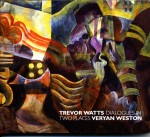 Dialogues in Two Places
Dialogues in Two Places
Trevor Watts; Veryan Weston
Hi4Head Records HFH 010D (www.hi4headrecords.com)
Confirmation of the Guelph Jazz Festival’s increasing importance on the international scene is this significant 2-CD set by British saxophonist Trevor Watts and pianist Veryan Weston. Both men have helped define improvised music since the 1970s, and during a rare North American foray in 2011, recorded one CD in Guelph and the other in Toledo.
Nationalism aside, the two appear more assured north of the border, with the climax, Cardigan, a 32 minute intermezzo. Three months earlier in Ohio they distributed their aleatoric and dextrous efforts among six much shorter improvisations. Playing both soprano and alto saxophones, Watts’ tone is sequentially taut, peeping, staccato and agitated in Toledo, while Weston’s lines encompass both formal pianism and near-splintered tremolo dynamics to extend and pivot the performances. Toledo’s high point appears on Glenwood. Here a contrapuntal intersection displays the saxophonist’s mercurial skills at speedy and slow tempos while compressing tones for nuance and colour. Also featured is the pianist initially accelerating, then halving the accompaniment, while moving from high-intensity chording and pounding to edgy soundboard and string plinking patterns.
Practically an invention on its own, Cardigan dramatically conveys the veterans’ familiarity with each other’s sound strategies and their ability to parry and thrust in split second intervals. The initial variations find Weston’s kinetic pumps, clips and unexpected octave jumps prodding Watts to move from reed bites and snorts into broken octave, aviary-like tremolos as the two explore the tune in tandem. By the exposition’s midpoint, metronomic keyboard cascades embolden the saxman to unleash a variant of circular breathing which culminates in juddering bagpipe-resembling tremolos. Soon afterwards Weston’s playful variations in the piano’s bass clef sustain the rhythm as he splays sharp harmonies. Leading to the finale, further developments find Watts echoing and shaking grace notes to affiliate with the pianist’s now low frequency, slow-paced chording. By the end pinched oboe-like reed bites replace an ocean-wide vibrato as Weston’s meticulous keyboard framing leads to parallel diminuendo.
Before a short encore, the applause from the Guelph audience is almost as protracted as the length of some of the Toledo tracks.



